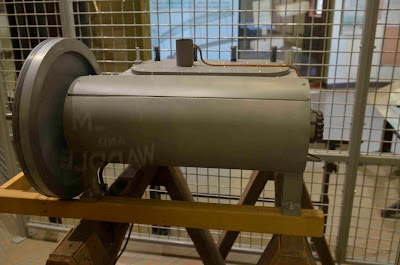We planned to spend the weekend in a state park in Illinois but there were no sites available so we took the road unplanned. With Indianapolis one of our destinations we turned southwest out of Pittsburgh. Looking at the map before we left, Jerry commented that Dayton was on the way and that it might be interesting to visit the Wright Brothers sites. That turned into an understatement of visiting four excellent museums on our four days in unplanned Dayton.
We started with the Aviation National Historic Park, primarily featuring the Wright Brothers.
The brothers grew up in a family of “talkers and tinkerers.” Their mother developed kitchen gadgets. Their father, a minister, once brought home a toy wooden gyrocopter.
That started the boys dreaming about flight. But first they had to make a living. While still in high school, they started in the printing business.
Then, like many other businesses of the time, they watched the growing popularity of bicycles and added those to their enterprise. They worked in this shop from 1895-97. This is the shop.
At the turn of the century, flying became their obsession. There were no classes or books to learn the physics of flying; it was all imagination, trial and error. These three traits they had in abundance. They flew kites, watched birds fly and tested their ideas. They used their bike-building knowledge to build gliders
This glider, a replica, was made of fabric on wood.
They built a wind tunnel to perfect the wings.
Their methodology was meticulous, or in Wilbur’s words
Their bicycle mechanic built their engine which was connected to the propellers with bicycle chains. It broke down a lot, but they just continued to make it better.
They solved the other problems of staying in the air, turning and control
They needed an open space with good winds and sand. Kitty Hawk, NC met their needs. There they tested their gliders. After several trips there and progress at a standstill, they were almost ready to quit. The exhibit emphasizes their perseverance which led to their success.
In 1903 Orville flew the first man-made power driven, heavier that air flight having hand carved their own propellers. This is the immortal photograph.
Yet they still faced and solved a list of problems: staying in the air, turning, control, wind shift and using a starting device.
They then moved their flight tests to Dayton to Huffman Field. On July 14, 1905, Orville crashed, was injured and the plane totaled. They changed design and by October they flew almost 40 minutes until they ran out of fuel.
The tests drew an audience. On the day Orville made the first man-made power driven, heavier than air flight at Huffman Field, a Mr. Stauffer said, “That durn thing kept going round and round.” It did, it flew almost forty minutes. They used a catapult to launch the airplane, much the same way launches are made today from aircraft carriers.
They stopped flying in order to gain patents on their inventions. In June, 1909 they were feted by the city of Dayton as local heroes and were awarded the Congressional Medal of Honor
Wilbur died in 1912. Orville continued to live in Dayton and tinker with new ideas until dying in 1948. He saw Lindbergh fly the Atlantic, commercial airplanes become common, and the breaking of the sound barrier.
The museum has two smaller exhibits. One is of the history of parachutes presenting them first as stunt items to their use in landing a cargo on Mars. The exhibits shows the idea of the parachute as far back as DaVinci up until now.
Another section tells the story of Paul Laurence Dunbar. A high school classmate of Orville, Paul Dunbar began the African American newspaper, The Dayton Tattler. A son of slaves, the only job he could find was as an elevator operator. From listening to people talk, mostly his own people, he started his writing career. He rose to literary prominence with his poetry of life as a “Negro” in America.
Before his early death he was honored by riding in a parade with President McKinley.
Our day ended with a beautiful sunset at Caesar Creek Campground.














No comments:
Post a Comment